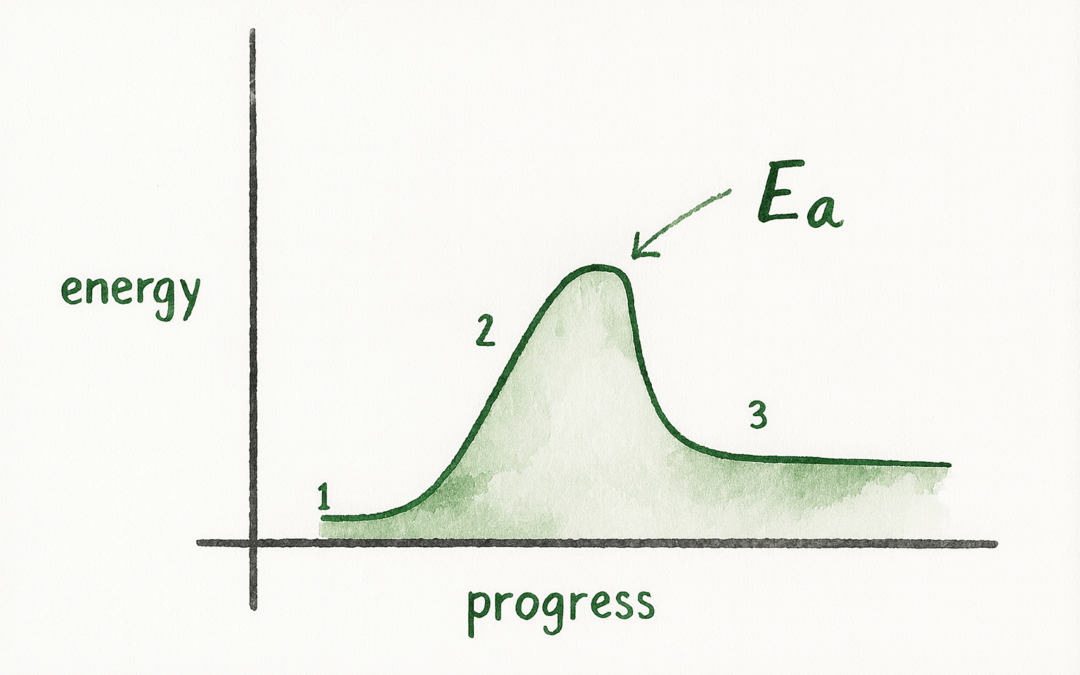Read time: 6 minutes
Key Points
- What is Activation Energy: Activation energy is the minimum energy needed to initiate a chemical reaction or change. It’s the push required to get things moving, whether in chemistry or in daily life.
- Daily Life Applications: Activation energy is a useful concept for understanding human behavior. It helps explain why getting started is often the hardest part of any task and how different forms of “catalysts” can make it easier to begin.
- Life Changes: Big life changes require a lot of activation energy. Understanding this can help you prepare for significant transitions or tasks.
- Chemical Context: Chemical reactions need activation energy to break existing bonds and form new ones. This is described by the Arrhenius equation, which relates activation energy to the rate of a chemical reaction.
“Energy can have two dimensions. One is motivated, going somewhere, a goal somewhere… There is another dimension of energy: unmotivated celebration. The goal is here, now; you are the goal.” — Osho, Tantra
Introduction: The Fundamentals of Activation Energy
Activation energy is the initial push or investment needed to set a process in motion. Originating from the realm of chemistry, the concept is critical for understanding how reactions occur and how to control them. But its application extends far beyond test tubes and Bunsen burners. Whether you’re trying to get out of bed in the morning, motivate a team, or make significant life changes, understanding activation energy can serve as a crucial mental model for initiating action.
How Activation Energy Works in Chemistry
In chemical terms, activation energy is the minimal energy required to break the bonds of reactants and form new bonds, thereby causing a reaction. The Arrhenius equation, formulated by Swedish scientist Svante Arrhenius, describes how temperature affects the rate of a chemical reaction and the required activation energy.
Activation energy serves as a protective barrier, ensuring that reactions don’t occur spontaneously and that a stable environment is maintained. For example, a book on a desk won’t spontaneously combust; it needs a certain amount of heat as activation energy to catch fire.
Catalysts: Accelerators of Change
Chemical reactions often require a certain amount of energy to initiate, known as “activation energy.”
Controlling these reactions can be challenging, especially when substantial energy is needed. Increasing temperature isn’t always a practical solution, for example, in biological systems like our bodies. Catalysis is a method used to speed up reactions by lowering the required activation energy, often through the addition of a catalyst—a substance not consumed in the reaction. This makes the reaction more manageable and efficient, even in industrial applications.
The concept extends metaphorically to life strategies. Energy aimed towards goals can be exhausting if one constantly chases a future outcome. In contrast, embracing the present as the goal leads to a fulfilling, relaxed state, where energy is not a means to an end but an end in itself, as described by Osho.
Activation Energy in Everyday Life
You might not think about chemistry when trying to motivate yourself or others, but the concept of activation energy is widely applicable. The principle can help you understand:
- Motivation: Different people need different types of ‘activation energies’ to get started. For some, it could be a motivational quote, while for others, it might be the pressure of an approaching deadline.
- Behavioral Changes: Major life changes, like quitting a bad habit, usually have high activation energy requirements. Recognizing this can help you identify the catalysts you might need to facilitate the change.
- Routine Tasks: Everyday activities, from getting out of bed to starting a new project, require a certain amount of activation energy. Identifying what that is can help you set up your day for success.
Principles of Activation Energy in Strategy and Decision-Making
- Individual Variation: Different people, and even the same person in different contexts, require varying levels of activation energy.
- Catalysts: Identifying the right catalyst can significantly lower the activation energy needed, making it easier to initiate a process.
- Energy Management: Your daily energy levels can affect the amount of activation energy you have at your disposal. Understanding your energy patterns can help you allocate your activation energy more effectively.
Mental Models and Related Concepts
- Micro-Tasks: Breaking down a daunting task into smaller components each requiring less activation energy can help initiate action.
- Incentives: Just as catalysts lower activation energy in chemical reactions, incentives can serve as catalysts in behavioral change.
- Timing and Rhythms: Understanding your natural circadian rhythm can help you identify when you have the most ‘activation energy’ during the day.
Daily Life Applications
The concept of activation energy, though rooted in science, can be applied as a mental model in our daily lives.
It represents the initial push or energy required to start a task or make a change.
For example, students may need various forms of “activation energy” to start writing an essay, such as a friend’s progress, blocking distractions, or an approaching deadline. Incentives can act as catalysts to lower the activation energy needed for tasks, like using dessert as a reward to get kids to eat vegetables.
This concept is also relevant for significant life changes, where reaching a breaking point serves as the necessary activation energy. The amount of activation energy required can vary based on one’s physical and emotional state, such as needing more coffee after a poor night’s sleep.
Applying the Concept of Activation Energy
- Identify Your Activation Barriers: What tasks or goals have you been procrastinating on? What is the ‘activation energy’ you need to get started?
- Find Your Catalysts: What can serve as a catalyst to lower the activation energy for your tasks? Is it a motivational video, a deadline, or social accountability?
- Understand Your Energy Levels: Are you a morning person or a night owl? When do you have the most energy to tackle challenging tasks?
- External Conditions: How do external factors like sleep, diet, and environment affect your ‘activation energy’? Can improvements in these areas make it easier for you to get started on tasks?
- Micro-Tasks: Can you break down a daunting task into smaller components, each requiring less activation energy, to make it easier to get started?
- Motivational Triggers: What are the triggers that usually get you moving? Is it competition, the fear of missing out, or the desire to excel?
- Monitor Catalyst Effectiveness: If you’ve identified catalysts, are they effective over the long term or do their effects diminish? Do you need to change them up?
- Activation Energy in Relationships: Are there interactions or conversations you’ve been avoiding? What activation energy is holding you back, and what catalyst could help you proceed?
- Energy Allocation: Are you spending your ‘activation energy’ wisely? Are you focusing it on tasks that truly matter in the long run?
Understanding and applying the concept of activation energy doesn’t require a degree in chemistry. The principle offers valuable insights into why initiating change can be difficult and how to make it easier. Whether you’re a leader, a change-maker, or someone interested in personal development, recognizing the importance of activation energy can be a game-changer.


excellent resource. What is the attribution of the source? Whoever wrote this did a really great job.